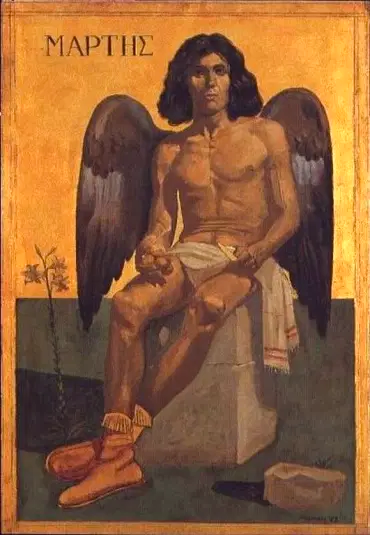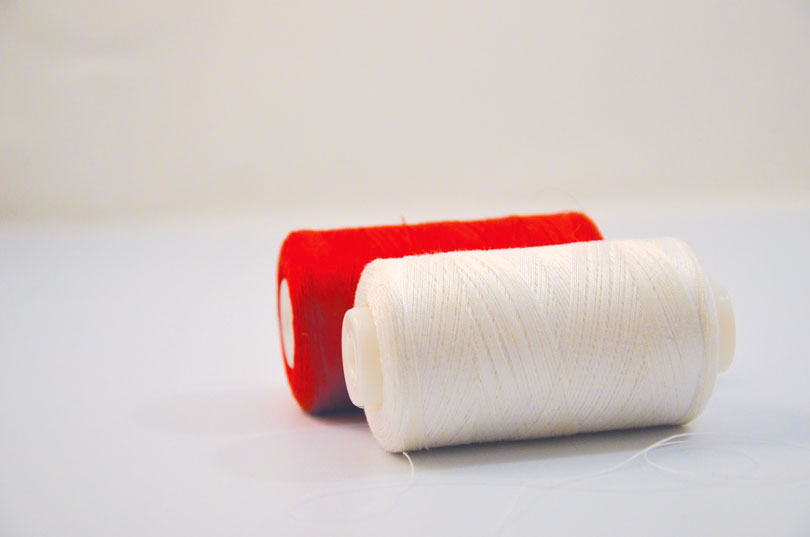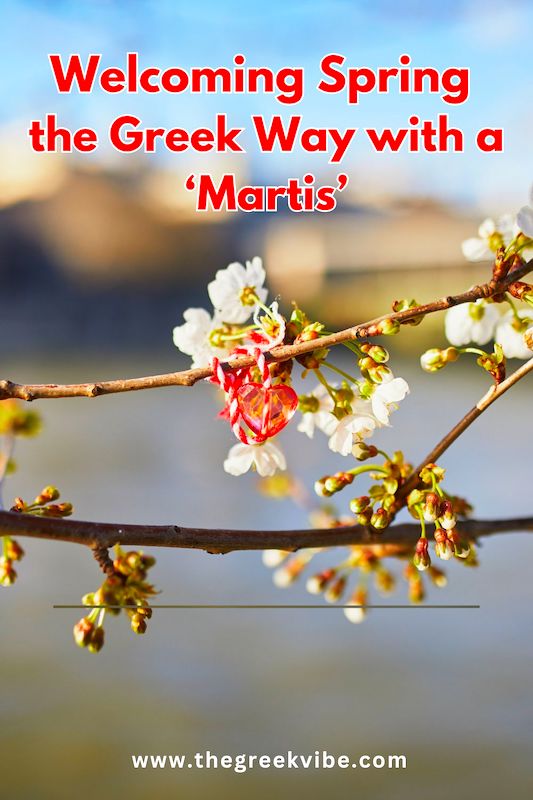
What’s the best way to welcome spring like a Greek? With a “Martis” of course! A beautiful homemade wrist band made with red and white thread that protects you from March’s harmful rays and evil ways! I remember my mother always making a Marti for my sister and I, which we would wear on March 1st. I felt so special when the kids at school – this was a Chicago suburb way back – would come around asking me about my Martis. My mom actually made a tiny Martis for my dolls too!
What is a Martis bracelet?

The Martis is a very thin band made with red and white threads that have been intertwined. Children make this bracelet on the last day of February and make sure to leave their homes for school wearing it around their wrist on the first day of the month.
In Greece, March 1 marks the beginning of spring – a festive day. The word “Martis” is the word for March in Greek. Come March, there is more daylight, you could hear the birds chirping (yes, even in the heart of Athens), the flowers are blossoming, bees are buzzing, and we are one month closer to summer, the beach and ice cream!
The Martis is an absolute must because according to Greek tradition it protects you from March and its tricky ways. To demonstrate: in Greek folklore you’ll find many proverbs about March and its unpredictable days and ways. Actually, the days in March are believed – very much like Groundhog Day in the US – to predict the weather all year round.
►Eight Great Books for Greece Lovers
One Greek saying goes something like this: “If in March (you wear a shirt), then in August a cape” or “Summer in March, winter in August”, “Better March in the corner, than March in the yard (better have rain in March and seek warmth in the corners than sun), “Playful March, sometimes in tears, others in laughter” and lastly, “March likes it two ways, one in 10 (days) sun and the others (days) freezing”. For the Greeks of the past who were mostly farmers, it was crucial that March bring rain so that there would be fertile soil and crops.

The Martis bracelet – also called “Martia” or “Martaki” – is also worn as a reminder not to trust the sunny days of March as they may seem warm and welcoming but they’re not. Which is very true! And I say so from personal experience. I remember one year my family and I had just come to Greece from Chicago. It was March and we had booked at a charming stone hotel on the seafront in Mani. After leaving our luggage, we all decided to go for a walk on the beach. It was so lovely and warm that we decided to sit in the sun for a couple of hours. When we returned to our rooms, we were all in chills and spent the night feeling sick. We couldn’t figure it out but yes, it was the ‘March effect’ (or heatstroke). We weren’t wearing a Marti by the way! Which is strange because my mother always had us wear one in the snowy March winters in Chicago.
So in the wise words of the Greeks: wear a Marti to remind you to steer clear of the temptation of sitting in the Greek sun in March for too long. The Martis was also a friendly warning to the farmers to remain cautious, active and to continue to work. “Summer is not here yet,” it seems to say.
►Three Perfect Greek Easter Getaways
The Greeks and The Martis Tradition

The Greek phrase “vale Marti gia na mi se piasei o ilios” means “wear a Marti so the sun doesn’t ‘catch’ you”. The tradition is believed to date back to Ancient Greece and to the Eleusinian Mysteries, when mystics would tie a thread, known as the “Kroki”, on their right hand and left foot. Wreathes worn in Ancient Rome and during Byzantine times were also considered to be a form of protection from the evil eye (also known as “vaskania” in Greek).
I would like to note that the Martis tradition is not unique to Greece. It can be found across the Balkans, in Cyprus where it is called “Martoui”, in neighboring Bulgaria, where it is known as “Martenitsa”, in Romania (Marchisor), Albania (Verore), Moldova, and Skopje.
The two threads combined symbolize “rebirth” and “renewal“, purity and joy, birth, life and a clean slate – a celebration of life which is what spring is all about.
► How to Live Long and Happy Like a Greek
When Do You Take Off the Marti

Tradition has it that the Martis is worn for the entire month and comes off with the arrival of Easter. Mind you, the Martis is never thrown away! Instead, you should take it off and burn it in the flame of your “lambada” (a votive candle that is used on the night of the Resurrection or “Anastasi” on Holy Saturday) ahead of Easter Sunday.
One more way is to burn it on Orthodox Easter Day in the fiery wood coal of your home’s “psistaria” where you are roasting your lamb. There are several beliefs behind the burning of the Martis bracelet. According to Orthodox custom, it represents the symbolic ‘burning’ of Judas who betrayed Christ. I however choose to believe that “burning” does away with any negative energies collected by the “martaki” in March. Much like the evil eye charms we wear to ward off the “mati” (negative energy) so does the Martis keep you safe from bad vibes coming your way.
🧿 Greek Evil Eye: 6 Tips to Avert the ‘Mati’
A more romantic way to let go of your Marti is to hang it on a tree branch and expect the arrival of cheerful swallows in spring to take it away and use it to create their nests.
You can alternatively leave your Marti on a fruit tree as a sign of good luck so the tree produces more fruit in the summer. One more belief says you should leave it under a stone. If you find a worm next to it the next day, the weather for the rest of the year will be fair. I prefer the birds and branch myself!
Why You Should Wear a Marti Today

First of all for fun! And also as a reminder that spring is here! For me as a Greek, it means so much more. It represents my mother’s love for her homeland and her efforts to keep it alive in her heart through tradition. And like I said, it also made me feel ‘special’ at school because everyone wanted one.
And yes, I still wear one and so do many adult Greeks today. I believe the red and white interwoven threads symbolize the promise of renewal. Winter (and hardship) is behind us, now it’s time to renew our faith in better, warmer days ahead.
Today, you could find all sorts of “Marti” charms – artsy, fancy, expensive, trendy, modern, with trinkets and evils eyes attached – but I strongly suggest you make your own. And to make it easier you could just get some red and white twine string. And why not make some for the people you love. It’s really not that hard and it’s always a great gift.
That said for those of you who want a Marti but are not good with your hands, I suggest this one which has 10 and can be given to students or children, this one again 10 in total which also have a heart charm and these with a bead.
👉🏼 Dream of visiting Greece? Start planning
♫ I end today’s post with a joyous spring-filled song by Rena Koumioti aptly titled “Martis” – a call to March to come earlier and to bring with it the singing birds and the blossoming Easter lilies. The song was released in 1972 to the lyrics of Lefteris Papadopoulos and the music of Vassilis Koubis.
Be well, travel!
❤️ Follow The Greek Vibe on TikTok too!
Enjoyed this Post? Share and Pin it!




